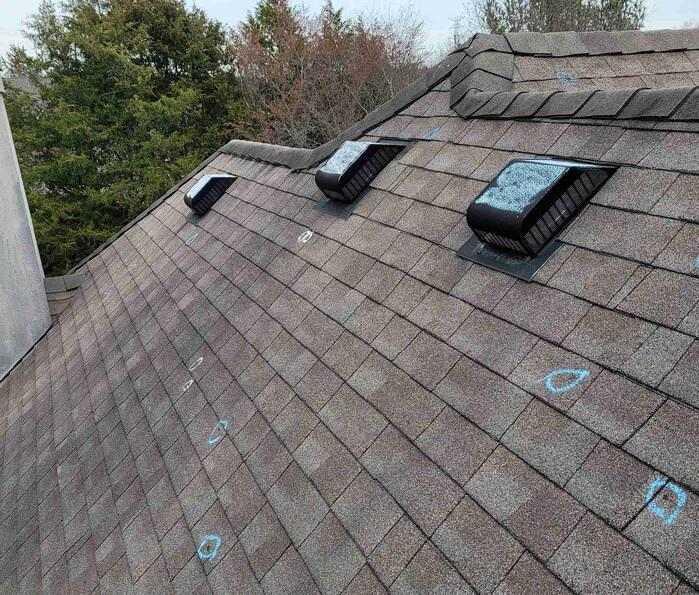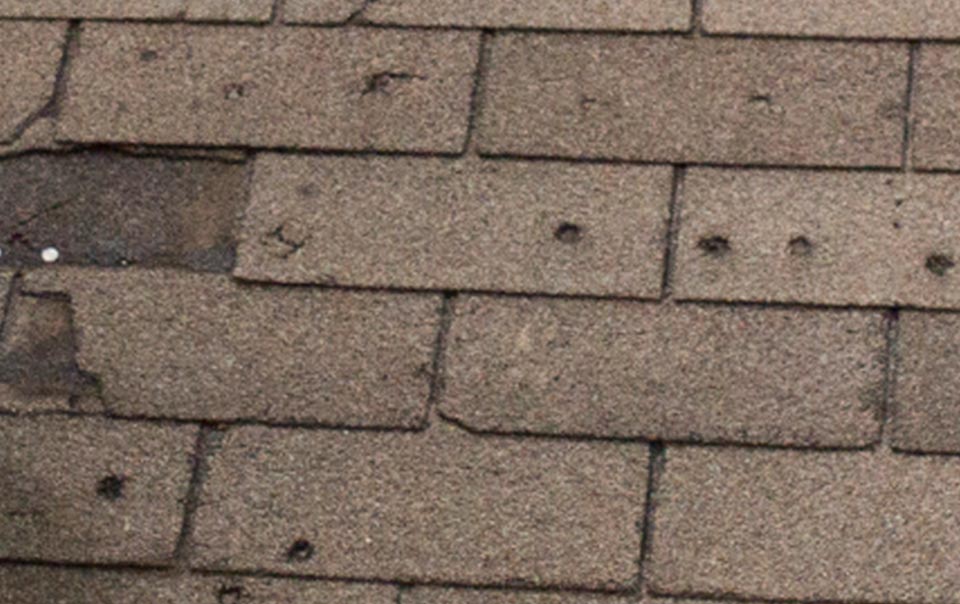Identify hail damage on your roof by examining for dents, cracked shingles, or damaged flashing. Granule loss on asphalt shingles often indicates hail impact.
Roof hail damage can compromise the integrity of your roofing system and lead to potential leaks or water damage. Homeowners should conduct a visual inspection after a hailstorm, searching for distinct signs of impact. Shingles may show a random pattern of damage with small divots.
Metal parts, like vents or flashing, are especially prone to hail marks. Prompt damage recognition allows for quicker insurance claims and repair work, maintaining your home’s protection. Remember, safety is paramount; consider using binoculars for a ground-level overview or hire a professional for a detailed roof inspection. Keeping your roof in top condition is critical to the longevity of your home.
Signs Of Hail Impact
After a fierce hailstorm, it’s crucial to inspect your roof for damage. Ignored hail damage can lead to costly repairs or even a full roof replacement. Recognizing the signs of hail impact is the first step in addressing any potential issues quickly and efficiently. Look out for these telltale indicators that hail has compromised the integrity of your roof.
Distinct Patterns Of Dents And Dimples
Hailstones often leave behind a unique signature on your roofing material. Distinct patterns of dents on metal roofs or dimples in roofing shingles can be easily spotted. These marks usually appear randomly, but uniformly across your roof’s surface, hinting at a hail hit. Hail damage might not always puncture through the material, but these impressions weaken your roof’s defense against future weather events.
Granule Loss On Asphalt Shingles
One of the most common effects of hail is the loss of granules on asphalt shingles — those tiny, sandpaper-like particles that coat the surface for protection and aesthetic appeal. Hail impact can loosen or dislodge these granules, exposing the underlying bitumen. Areas of granule loss can be spotted by looking for inconsistencies in the shingle color or collecting loose granules in gutters. This not only accelerates the aging of your roof but also diminishes its water-shedding capabilities.
Cracks And Splits In Shingles
Another sign to watch for is cracks or splits in the shingles. Hailstones can inflict sharp blows that crack or split shingles upon impact. These fissures may be subtle or pronounced, and they can allow water to seep through and cause extensive damage to the underlying layers of the roof and eventually to the interior of your home. Immediate attention to such damage can prevent further deterioration and costly repairs.
In conclusion, identifying hail damage early on is vital for maintaining the longevity and effectiveness of your roofing system. Keeping an eye out for these signs ensures your roof continues to protect your home as it should.

Credit: www.billraganroofing.com
Diy Inspection Safety Tips
Identifying hail damage on your roof is critical to maintaining the integrity of your home. Performing a DIY inspection can help you assess any damages, but it’s imperative to do so safely. The following safety tips will guide you on how to conduct a thorough inspection without compromising your well-being.
Appropriate ladder use and placementAppropriate Ladder Use And Placement
When it comes to roof inspections, your ladder is your best ally. Ensure to choose a ladder that extends at least three feet over the edge of the roof. This allows for added stability and safety. Follow these steps for safe ladder use:
- Inspect: Before using, check the ladder for any signs of damage or wear.
- Stable Ground: Place the ladder on solid, level ground. Avoid loose gravel or soft soil.
- Secure Placement: Ladder feet should be anchored with a board or ladder stabilizer to prevent slipping.
- Proper Angle: The base of the ladder should be one foot away from the wall for every four feet of height.
- Lock-in Place: Fully extend a telescopic ladder, and ensure it’s locked in before climbing.
Choosing The Right Footwear
Footwear is not just about comfort; it’s about safety. The ideal footwear should provide grip, support, and protection. Consider the following when selecting roofing shoes:
| Feature | Description |
|---|---|
| Non-Slip Sole | A rubber sole with deep treads offers the best traction on a roof. |
| Supportive Fit | Snug-fitting shoes provide ankle support to prevent twists and sprains. |
| Durable Material | Heavy-duty materials defend against punctures from roof debris. |
Weather And Time Of The Day Considerations
- Avoid Wet Conditions: A wet roof is a hazardous surface. Inspect when it’s dry.
- Ideal Lighting: Optimal visibility is crucial. Perform inspections during daylight with clear, sunny conditions.
- Moderate Temperatures: Extreme temperatures can affect roof materials and your ability to safely move about. Choose a moderate day for inspection.
- Wind Factor: Even a mild breeze can pose a risk when high up. Avoid windy days for roof inspections.
Spotting Subtle Roof Damage
Post-storm assessments often overlook the finer nuances of hail-induced harm, placing properties at risk for leaks and deterioration. Keen observation is vital. This section demystifies the nuances and indicators of elusive roof damage caused by hail, guiding homeowners through a detailed inspection process.
Metal Components Hits
Inspecting the metal parts of your roof can be particularly telling. These areas, although sturdy, bear the initial brunt of hail’s fury. Look for dents or unusual patterns on:
- Metal flashings
- Vents
- Gutters
- Downspouts
Any indentations or punctures act as red flags, signaling an immediate need for a professional evaluation.
Damage To Soft Roof Coverings
Hailstorms can ruthlessly batter soft roof coverings. To identify if your roof has suffered damage:
- Initiate a ground-level visual inspection for visible signs of surface disruption.
- Seek out areas appearing bruised or exhibiting a darker hue, suggesting compromised integrity, particularly in roofing felts.
- If safety permits, perform a tactile examination for subtle indentations.
Tread with caution; some signs might not be visually apparent and might require a roofer’s expertise.
Hail Impact On Different Shingle Types
Roof shingles, varying in material, display distinct signs when pelted by hail. The common shingle types include asphalt, wood, and composite, among others. Visual inspection hints include:
| Shingle Type | Damage Indicator |
|---|---|
| Asphalt | Loss of granules, exposing the substrate |
| Wood | Splitting with sharp edges and impact marks |
| Composite | Disintegration or localized fracturing |
Each type demands an in-depth assessment for granule loss, cracks, or splits, which might be subtle yet significant enough to compromise the roof’s protective capabilities.
Professional Roof Inspection
Discovering the signs of hail damage on your roof can be challenging for an untrained eye. While some damage may be obvious, such as cracked shingles, other types of damage can be subtle and insidious. This is where the expertise of a professional roof inspection becomes invaluable. Professional inspectors are equipped with the knowledge and tools to identify all levels of hail damage, ensuring that your roof remains in optimal condition to protect your home.
When To Call Roofing Experts
Engaging roofing experts is a critical step, particularly after severe weather events. Instances that necessitate a professional inspection include:
- After a major hailstorm
- If neighbors are getting roof repairs
- When selling a home and ensuring its condition
- Regular annual or bi-annual maintenance checks
Benefits Of A Professional Assessment
- Detailed damage detection: Professionals can spot subtle signs of hail damage that homeowners might miss.
- Insurance claims expertise: Inspectors can provide the necessary documentation to support insurance claims.
- Safety: Experts can safely navigate a roof, whereas homeowners risk injury.
- Long-term savings: Early detection and repair can prevent more costly damage down the line.
Understanding The Inspection Process
The roof inspection process conducted by professionals usually includes:
| Step | Description |
|---|---|
| 1. Initial Consultation | Discussing homeowner concerns and inspection goals. |
| 2. On-site Assessment | A thorough examination of the roof’s surface, structure, and attic spaces if accessible. |
| 3. Documentation | Compiling a comprehensive report with photographs and a damage assessment. |
| 4. Recommendations | Providing guidance on the necessary repairs or replacements. |
| 5. Follow-up | Discussing next steps and answering any questions about the inspection findings. |
Seamlessly blending experience with technology, inspectors utilize tools such as drones and moisture detection equipment to assess your roof’s condition meticulously. This sophisticated approach ensures that every aspect of hail damage is discovered and appropriately addressed.
Immediate Steps To Prevent Leaks
Discovering hail damage on your roof can be alarming, and taking prompt action is crucial. Immediate steps to prevent leaks minimize water intrusion, ensuring your home remains safe and dry. Here’s how you can implement quick-fix solutions and prepare for a long-term resolution.
Temporary Fixes and CoveringsTemporary Fixes And Coverings
A quick response can protect your home from further damage. Following a storm, start by assessing the extent of the hail damage.
- Self-Adhesive Waterproof Flashing Tape: Apply this over cracks or holes as a short-term solution.
- Tarp Coverings: For larger areas, a heavy-duty tarp pinned down securely can offer solid protection.
- Sealant: Use a high-quality roof sealant to cover smaller punctures temporarily.
Documenting Damage For Insurance Claims
It’s essential to thoroughly document any hail damage for insurance purposes.
- Take Clear Photos: Capture all affected areas of the roof from multiple angles.
- Record the Date and Time: Note when the hail event occurred, as this is often required by insurance companies.
- Maintain Records: Keep all receipts for temporary repairs, as these costs might be covered by your policy.
Providing a complete set of documents can streamline your claims process and help secure proper coverage for repairs or replacement.
Choosing Between Repair and ReplacementChoosing Between Repair And Replacement
Deciding whether to repair or replace a hail-damaged roof depends on various factors:
| Extent of Damage | Roof Age | Material Warranty |
|---|---|---|
| Minor, isolated areas | New or mid-life | Not close to expiration |
| Widespread, multiple areas | Aging or end-of-life | Nearing expiration or expired |
Consult with a qualified roofing professional for an accurate assessment. This expert input is invaluable in making an informed decision that protect both your home and investment.
Frequently Asked Questions Of How To Identify Hail Damage On Your Roof
What Are Signs Of Hail Damage On Roofs?
Signs of hail damage include dents on shingles, missing granules, exposed roof felt, and cracks in the shingle surface. These damages can compromise the roof’s integrity and may lead to leaks.
How To Differentiate Hail From Other Roof Damage?
Differentiating hail from other damage involves checking for distinct patterns of dents or bruising consistent with hail impact. Look for uniform damage distributed across the roof, often with punctures or splits in shingle edges.
Can Hail Damage To Roofs Be Repaired?
Yes, hail damage can be repaired. Minor damage might only require shingle replacement, whereas severe cases could necessitate a full roof replacement. It’s important to have a professional assessment for proper repair guidance.
How Often Should Roofs Be Checked For Hail Damage?
Roofs should be inspected for hail damage at least annually, but assessments should also occur after significant hailstorms or extreme weather events. Regular checks help in early detection of any hail damage.
Conclusion
Identifying hail damage on your roof is crucial for maintaining your home’s integrity. Regular inspections after storms can save you from costly repairs. Remember, spotting shattered granules, dents, or bruises early keeps your home secure. Ensure your peace of mind, check your roof routinely, and seek professional evaluations when needed.
Protect your investment with vigilance.

